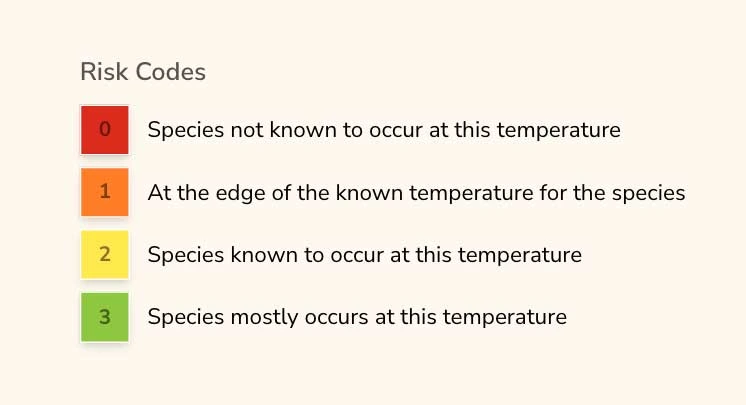
Lenny Sciulli, B.S. Plant Sciences, Class of 2024.
Throughout his final year in the School of Plant Sciences, undergraduate student Leonardo ("Lenny") Sciulli conducted an evaluation of the climate risk of the tree species of the University of Arizona Campus Arboretum and Tohono Chul Gardens collections. After combining the list of tree species from the inventories of both gardens, Lenny used the Botanical Garden Conservation International's Climate Assessment Tool (BGCI CAT) to rank species for their potential to perform in Tucson under current or future climate scenarios. The CAT leverages data from the Global Tree Database, (Global Trees Search) that maps observations of ~60,000 tree species from more than 500 different sources around the world. Based on these global observations of species with Mean Annual Temperature (MAT) similar to that in Tucson (currently MAT is 21ºC) Lenny aimed to evaluate the potential risk to the two Tucson collections. This compliments known performance observations of the species from recent history. The tool also rates risk for tree species growing in MATs corresponding to that expected in two potential climate scenarios: SSP2 (23.6ºC) and SSP4 (26.5ºC). Upon entering a geographic location and a particular species name, the CAT assigns a risk code of 0-3 based on frequency of observations of that species in regions with the targe region's MAT (ie, for Tucson currently: 21ºC). The colour coding can provide quick insight as to whether the climate is becoming too warm for a taxon, or if the climate maybe warming up into a climate preferred by the taxon.

Risk Code 0 indicates that there are no current records of the taxon growing at this within the region's MAT. The lack of records for a specific taxon, they interpreted as an reflection of a lack of recorded observations, but not necessarily potential plant performance.
Risk Code 1 indicates that there are few known occurrences of this taxon growing within the region's MAT. This, they interpret as meaning that the specified MAT is near the limit of known occurrences for that species. As such, the taxon may be able to be grow at temperatures experienced in this region, but care regarding its microclimate, context and vulnerability to other factors such as pests and diseases may be required.
Risk Code 2 indicates that the species does occur within the region's MAT. This, they interpret as meaning that the taxon may be well suited to the MAT but that is not likely the most preferred climate for the species.
Risk Code 3 indicates that the species is mostly found growing within the region's MAT. This, they interpret as meaning that at the specified MAT, the species is expected to be within its preferred temperature range.
The example shown here (below) reflects the climate risk assessment result obtained from the CAT for a tree species grown in the Campus Arboretum collection based on the MAT of 23.6ºC (SSP2 Climate Scenario). On the basis of 672, 0 or 3 observations of this species in natural or urban settings (GBIF), modelling predictions (Model) or in botanical gardens (Plant Search), respectively, we can see that Senegalia mellifera mostly occurs in regions with a MAT of 23.6ºC. As such, it may have promise to perform well in Tucson under the SSP2 Climate Scenario. However, further more nuanced evaluation of environmental adaptation is needed before conclusions about likely performance can be drawn.

Lenny conducted the assessment by entering in all tree species from the two Tucson collections into the CAT. From this, he obtained climate ratings for all ~800 species. Of those, many appeared to be promising for Tucson's current climate, and a few others have promise to perform well under future climate scenarios. Interestingly, he identified 19 species with low risk scores in multiple climate scenarios. These, may be able to perform well if grown in current climate and could potentially continue to do well in the face of climate change. This list of species are shown in the table below. For a complete understanding of the work Lenny completed, see the associated Research Page.
| Tree Species | Common Name |
| Boswellia sacra | frankinscence |
| Bursera laxiflora | alamos tree |
| Coursetia glandulosa | bonnets |
| Faidherbia albida | apple ring acacia |
| Fouquieria burragei | gulf ocotillo |
| Fouquieria formosa | palo santo |
| Fouquieria purpusii | caudex ocotillo |
| Havardia pallens | tenaza |
| Jatropha cordata | papelío |
| Maytenus phyllanthoides | mangle dulce |
| Parkinsonia praecox | Sonoran palo verde |
| Populus mexicana | Mexican poplar |
| Sabal uresana | Sonoran palmetto |
| Senegalia mellifera | blackthorn |
| Senegalia occidentalis | Sonoran catclaw |
| Vachellia erioloba | smooth vallesia |
| Vachellia tortilis | umbrella thorn acacia |
| Vallesia glabra | smooth vallesia |
| Vallesia laciniata | vallesia |
Future work will evaluate potential performance based on the high and low temperature tolerance of the promising species Lenny identified. It will further limit the list based on precipitation and the experiences of practitioners familiar with cultivation of each species.

